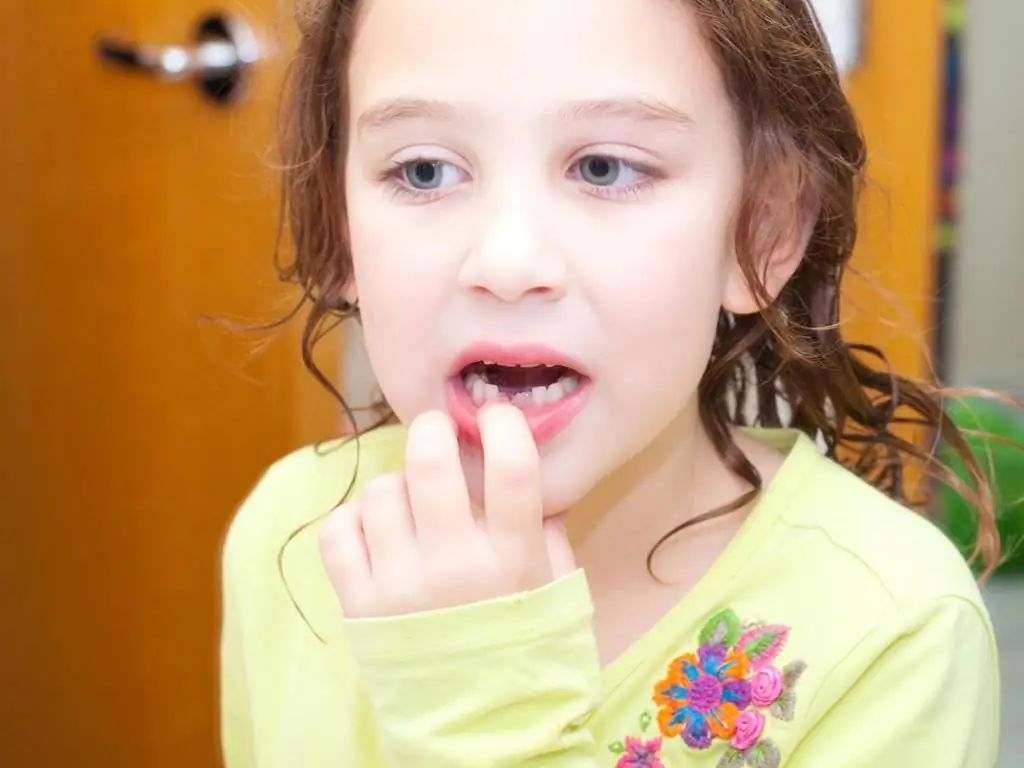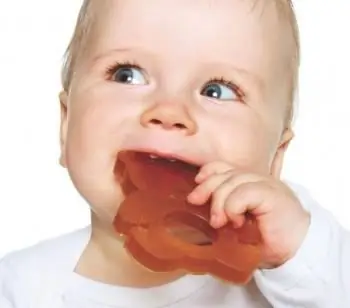2026 Author: Priscilla Miln | [email protected]. Last modified: 2025-01-22 17:55:15
Teething is one of the main stages in the development of a baby up to one year old. During this period, the behavior of the baby can change dramatically. This is due to the fact that the baby feels discomfort. There may be pain in the gums, an increase in body temperature. Teething may be accompanied by other symptoms as well.
Young parents need to know when the first teeth are being cut, how this process occurs and what needs to be done. They need to study the features of its course, precautions, possible complications. This is necessary in order to be able to prepare for this period. In addition, it is important to understand how you can help a small child survive the stage of eruption of milk teeth and facilitate its course, what measures to take.
When do teeth start to erupt?

Many young parents are interested in what time teeth are cut, at what age? As a rule, the first teeth in a baby begin to erupt at the age of 6-7 months. However, there may be deviations up or down.
The onset of "moment X" depends on several factors, including:
- heredity;
- child nutrition, saturation of the body with calcium;
- features of the climatic conditions in which the baby lives;
- baby gender.
Girls' teeth begin to appear earlier. In addition, babies in hot climates start teething earlier.
Which teeth come in first?

The lower incisors begin to erupt first. However, there are cases when other teeth erupt first. This is not a deviation from the norm, but due to the individual characteristics of the organism. Characteristically, the teeth appear in pairs. By the end of the first year of life, a child may have 8 or more teeth.
Very often in formula-fed babies, the process of teething begins earlier, at about 4-5 months. According to experts, parents should not be alarmed by the absence of teeth in a baby who has reached the age of one. However, in some cases, this indicates the presence of certain pathologies.
Why do teeth take so long to come in?

If the child is 9 months old, and the process of teething milk teeth has not begun, this may indicate that the child has some pathologies. These include:
- infectious diseases, intestinal disorders over a long period of time;
- vitamin D deficiency, rickets;
- metabolic disorder;
- transmitted infectious diseases in prenatalperiod can cause a violation of the order of eruption of milk teeth or provoke the absence of any tooth.
Adentia is possible - a phenomenon characterized by the complete or partial absence of tooth buds. However, it is extremely rare. And in most cases, adentia is due to the genetic predisposition of the child or the diseases suffered by the woman during the period of bearing the child.
In addition, the untimely appearance of teeth, and even in the wrong place, may be due to the horizontal position of the tooth.
To exclude the presence of pathologies, it is recommended to seek advice from a pediatrician and pediatric dentist. If necessary, specialists will prescribe additional examinations and determine the cause of missing teeth.
How teeth are cut: symptoms

The appearance of teeth is an important and at the same time very difficult stage for every baby and his mom and dad. That is why many young parents are concerned about how to understand that teeth are being cut? As a rule, the process of eruption of milk teeth in a child is accompanied by the appearance of specific symptoms:
- Redness and swelling of the gums. This phenomenon can appear a few days or even weeks before the appearance of teeth. During this period, the gums begin to itch strongly. Pain occurs.
- Increased salivation.
- Sour smell from the mouth of a baby, due to the decomposition of particles of the mucous membrane.
- Cheek swelling.
- The child pulls all objects into his mouth, thustrying to get rid of the itching on the surface of the swollen gums.
- The child becomes capricious, excitable, constantly asking for hands.
- Rhinitis.
- Stool disorder, constipation, diarrhea.
- Cough.
In addition, the appearance of a baby's teeth may be accompanied by a deterioration in appetite. Vomiting and frequent regurgitation are possible. Often, the process of teething milk teeth is accompanied by an increase in basal body temperature.
The baby's sleep becomes intermittent. The baby often wakes up crying. A rash may appear on the gums in the form of red blisters.
It is important to note that not all of the above symptoms may appear at the same time. It depends on the individual characteristics of the organism.
It is important for parents to study in advance the possible symptoms that occur during the teething period. Photos of babies who begin this process are presented in the article.
Danger signs that should alert you
During teething, the baby's immune systems weaken, the body becomes susceptible to infections and viruses. Therefore, at this stage of the development of the baby, young parents need to provide even more care to the child and extremely carefully monitor the he alth of the baby, monitor his emotional state.
It is very important for parents to be able to distinguish the symptoms of teething from the signs of a cold.
Cough during teething is possible and is caused by the production of excess saliva, which flows down the throat and causes a cough reflex. Usually a coughmoist and aggravated when the child is in a horizontal position. It rarely appears, about 7-8 times a day. If the cough intensifies and begins to cause discomfort to the child, you should immediately contact the pediatrician to prevent the infection from entering the baby's body.
Increased nasal discharge is important to distinguish from a runny nose that accompanies a cold. If the discharge becomes yellowish or greenish and continues for more than four days, you should also contact your pediatrician.
Diarrhea during teething is also possible. Diarrhea that occurs in an infant during this period is due to increased salivation, leading to an acceleration of intestinal motility. Young parents should be alerted to abundant and frequent (more than 3-4 times a day) diarrhea. This is a reason to contact a specialist for advice.
If the immune system of the baby's body is weakened, diseases of the oral cavity may occur during the appearance of teeth:
- stomatitis;
- thrush.
Temperature rise
Very often during teething, there is an increase in body temperature of a small child. The normal reaction of the body is an increase in basal temperature to 38 degrees. If the increase reaches 38.5 degrees or more, you should immediately contact your pediatrician. Since such an increase indicates the presence of a cold and requires treatment.
Rise in temperature that accompanies teething,observed, as a rule, within two to three days and is easily eliminated with an antipyretic.
Medicines that relieve teething symptoms

Local anesthetics in the form of an ointment or gel will help relieve pain during teething. You can buy such a remedy at any pharmacy without a doctor's prescription. Currently, there are a huge variety of gels and ointments from different manufacturers.
In addition, homeopathic drops and suppositories can help the child. They will relieve the symptoms and help to improve the emotional state of the young child.
The most popular medications are:
- "Dantinorm";
- "Dentokind";
- "Nurofen";
- "Baby Doctor "First Teeth";
- "Pansoral "First teeth";
- "Kalgel";
- "Holisal".
Before you start using, you need to carefully study the instructions and read about the dosages of drugs and possible contraindications.
Medications are divided into three groups depending on the main active ingredient:
- homeopathic;
- cooling;
- anti-inflammatory.
The effect of anti-inflammatory gels and ointments is longer than that of the two analogues.
Folk remedies

Cope with the pain ofbaby during teething, traditional medicine will help. It is worth noting a few of the most common and effective ways:
- Warm tea made from medicinal herbs: lemon balm, chamomile, lavender or catnip.
- Clove oil, which has a unique analgesic effect and relieves inflammation on the baby's gums.
- Chamomile, which also has anti-inflammatory and soothing effects. A more concentrated solution based on this plant can be rubbed into the baby's gums, and a less concentrated solution can be drunk.
- Valerian is a universal sedative. A solution based on valerian must be infused for three days. After that, you need to regularly rub it into the swollen gums of the baby.
Well proven in the fight against pain during teething honey. Lubrication with honey can only be done if the child is not allergic.
How long does teething take?
Many parents are interested in how long the first tooth and all subsequent ones are cut? The duration of this process is different for each child. The first tooth may appear within three days or even a week of gum swelling.
After the appearance of the lower incisors, the eruption of the upper central teeth begins.
How to help a baby?
When the teething process begins, the question becomes relevant, when teeth are being cut, how to help the baby, what needs to be done to alleviate his suffering? Help the baby in the period of the appearance of the first andsubsequent teeth can. The child is recommended to give cool vegetables and fruits, which are an excellent tool for massaging the gums. The products not only massage the gums, but also cool them, producing an analgesic effect.
Besides, mother can make cold lotions. To do this, take a small piece of gauze and soak it in cool water. Use a soft toothbrush to massage swollen baby gums.
By the way, special finger toothbrushes are currently sold in pharmacies, which are an excellent tool for massaging. For this purpose, special teethers and "scratches" for gums, which are freely available in any pharmacy, are also suitable. You can buy them at an affordable price.
In addition, during teething, it is recommended to put the baby's head on a slight elevation. This will draw blood away from the gums and reduce the intensity of pain.
Can I walk?

Besides, teething is not a reason to refuse daily walks in the fresh air. Walking is necessary for the baby to develop properly. The reason for refusing them is an increase in the baby's body temperature, as well as a suspicion that an infection or virus has entered the baby's body.
If parents suspect a cold rather than teething to be the cause of restless behavior, runny nose and other symptoms, it is best to postpone walks until the baby improves and is fully stabilized.
Can I dovaccinations?
Teething is a physiological process and is not a reason to refuse vaccination. Most vaccines are well tolerated by the body of a small child. But there are vaccinations, after vaccination with which the emotional state of the baby does not change for the better. The baby becomes capricious, an increase in basal temperature is possible. One such vaccine is DTP.
Experts strongly recommend during teething to refuse this vaccination. Vaccination is recommended to be postponed until the condition of the child's body is completely stabilized.
Instead of a conclusion
Teething is an important and inevitable period in a baby's development. This is a strong blow for a small organism. It is important for parents to know about the peculiarities of the process of teething, about possible symptoms and complications that occur when teeth are cut. The symptoms are very similar to those of a cold. That is why parents often confuse the process of the appearance of milk teeth with a cold. When teeth are cut, the body temperature of a small child often rises, coughing and runny nose may occur. In addition, teething may be accompanied by vomiting and frequent spitting up.
In any case, the baby's parents should know what measures to take when teething, what to do. In this way, mom and dad can help a small child go through this stage easier, make it less painful and restless.
It should be understood that if the child's condition worsens duringfor a long time, it is necessary to immediately call a pediatrician or visit a children's clinic on your own, since the symptoms that accompany teething are very similar to those of ARVI and a cold.
Recommended:
Can teeth be cut at 2 months: stages of child development, teething norms and opinions of pediatricians

Even those women who have not become a mother for the first time may wonder if teeth can be cut at 2 months. In some babies, signs of teething appear earlier, in others later, everything is purely individual, and any pediatrician will confirm this. It happens that teeth erupt almost imperceptibly for parents. Other children experience all the "charms" of this time. Let's talk in the article about whether teeth can be cut at 2 months, how this happens, and whether it is a pathology
When teeth are being cut, how to help a child?

When a child is teething, not all parents know how to help. This article describes several ways to alleviate the suffering of the baby
Rhinitis when teething. Teeth are cut: how to help?

Teething is a real challenge not only for children, but also for parents. One of the most common teething symptoms in babies is a runny nose. Every mother should know how to relieve a baby from a runny nose and relieve pain
Change of milk teeth in a child: terms, age limits, procedure for changing teeth, features of the process and advice from parents and doctors

As a rule, children's teeth fall out at a certain age. However, sometimes they are replaced earlier or later than the due date. Let's see what it could be. It is also worth studying the useful recommendations of experts
Useful tips. When does a child cut teeth?

There are many stages in the life of a little person, some of which are not pleasant. These, of course, include the period when the first teeth begin to cut in babies. This condition upsets not only children, but also parents. Not everyone can stand the constant crying of a beloved child. On average, the first teeth begin to appear closer to six months. When a child is teething, moms and dads need to gather their will into a fist and help the baby. How to do it, read below

